
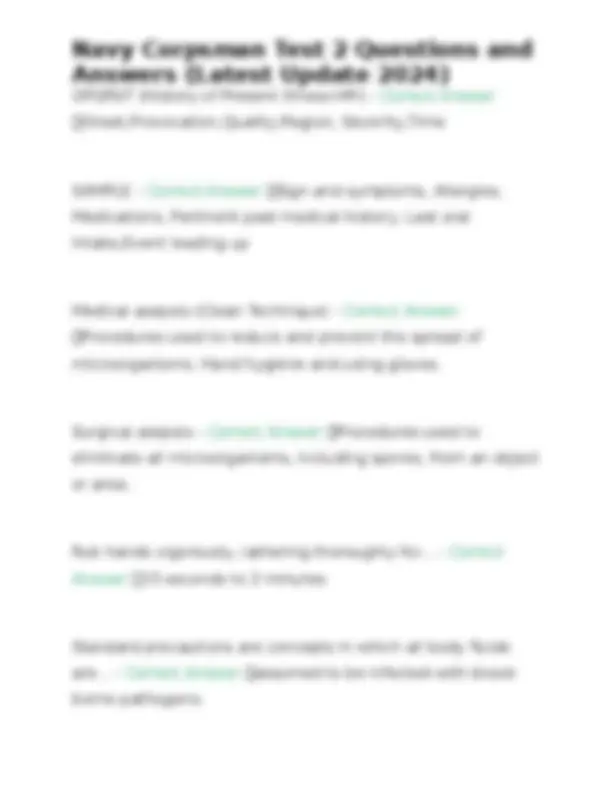
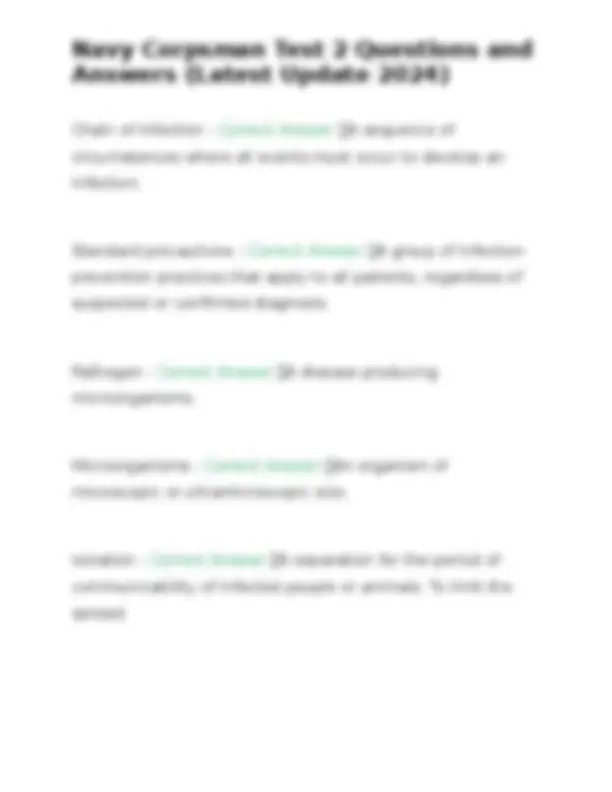
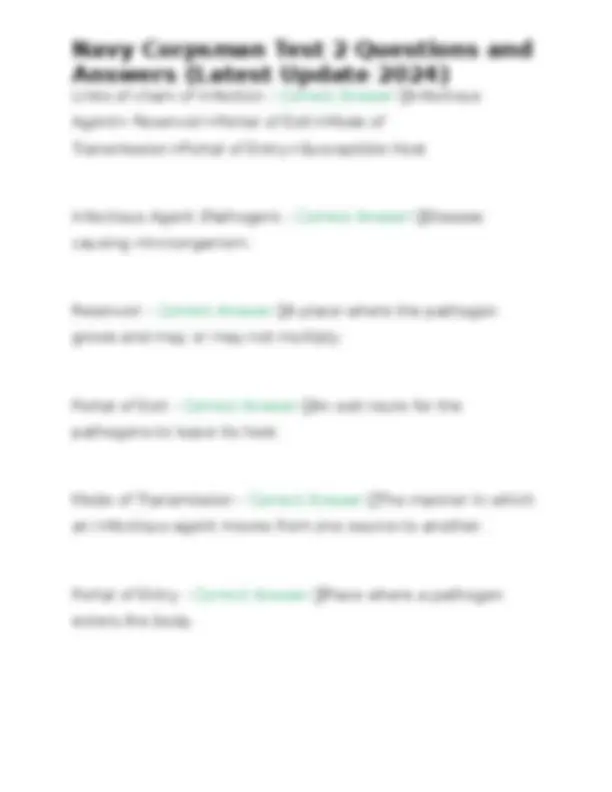
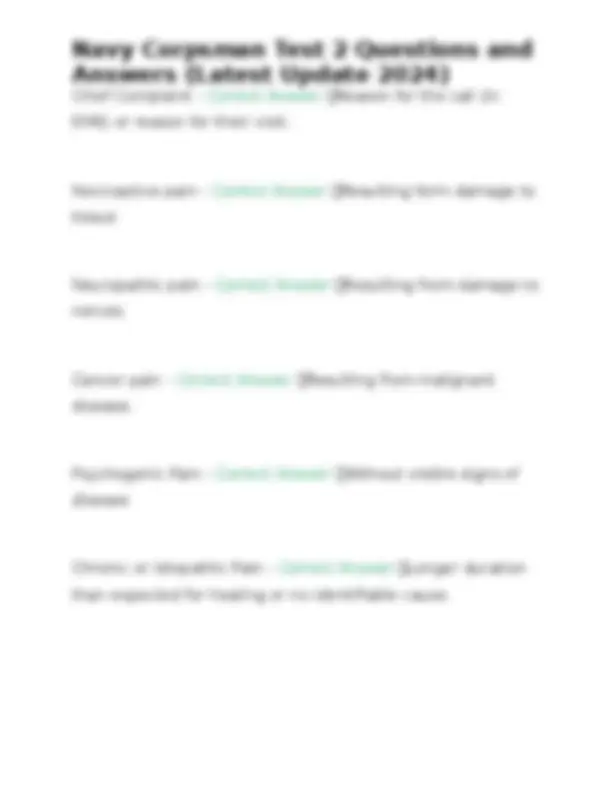
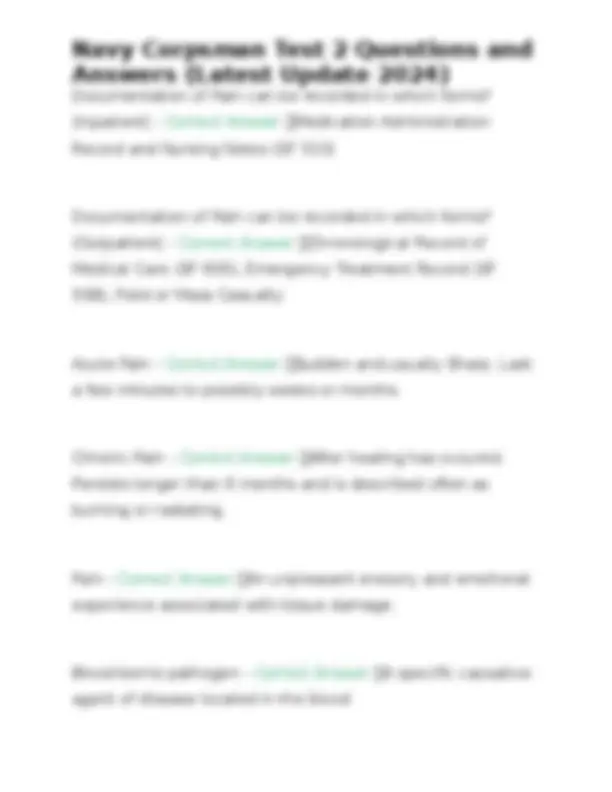
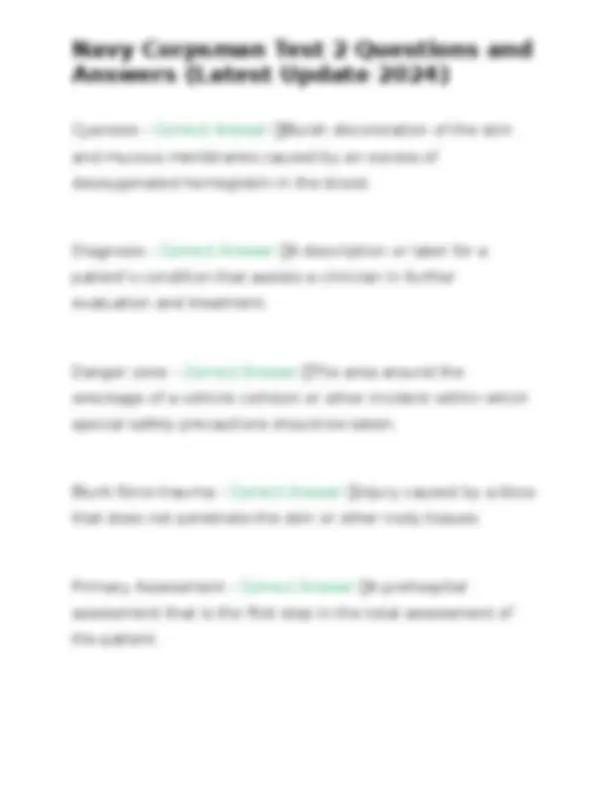


Study with the several resources on Docsity

Earn points by helping other students or get them with a premium plan


Prepare for your exams
Study with the several resources on Docsity

Earn points to download
Earn points by helping other students or get them with a premium plan
Community
Ask the community for help and clear up your study doubts
Discover the best universities in your country according to Docsity users
Free resources
Download our free guides on studying techniques, anxiety management strategies, and thesis advice from Docsity tutors
A comprehensive set of questions and answers related to the navy corpsman test 2. It covers a wide range of topics, including antibacterial and antiseptic agents, respiratory conditions, vital signs, infection control, and various types of trauma. The document aims to help navy corpsmen prepare for their upcoming test by providing them with the latest and most relevant information. The questions and answers are presented in a clear and concise manner, making it easy for the reader to understand and retain the key concepts. This document could be a valuable resource for navy corpsmen who are studying for their certification exam or for those who want to refresh their knowledge on these important medical topics.
Typology: Exams
1 / 12

This page cannot be seen from the preview
Don't miss anything!







Antibacterial - Correct Answer ✅Directed or effective against bacteria Antiseptic - Correct Answer ✅Preventing or arresting the growth of microorganisms Dyspnea - Correct Answer ✅Labored or difficult breathing Apnea - Correct Answer ✅Absence of breathing Tachypnea - Correct Answer ✅Excessively rapid breathing Respiration - Correct Answer ✅Measurement consists of one inhalation and one exhalation Blood Pressure (B/P) - Correct Answer ✅The force that circulating blood exerts against artery walls as the heart contracts and relaxes. (mmHg)
Systolic pressure (SBP) - Correct Answer ✅The pressure created in the arteries when the heart contracts and forces blood out. First sound you hear. Diastolic blood pressure (DBP) - Correct Answer ✅The pressure remaining in the arteries when the heart is relaxed. Last sound you hear. Perfusion - Correct Answer ✅Blood flow through tissue, providing oxygen and nutrients while also removing waste. Hypotension - Correct Answer ✅Abnormally low blood pressure; may cause insufficient perfusion of internal organs Hypertension - Correct Answer ✅Abnormally high blood pressure; may cause rupture of the arteries and destruction of organs. Vital Signs - Correct Answer ✅Temperature, Pulse, Blood Pressure, Respiratory Rate, Pulse Oximetry (SPO2), and Pain
Chain of infection - Correct Answer ✅A sequence of circumstances where all events must occur to develop an infection. Standard precautions - Correct Answer ✅A group of infection prevention practices that apply to all patients, regardless of suspected or confirmed diagnosis. Pathogen - Correct Answer ✅A disease producing microorganisms. Microorganisms - Correct Answer ✅An organism of microscopic or ultramicroscopic size. Isolation - Correct Answer ✅A separation for the period of communicability of infected people or animals. To limit the spread.
Links of chain of infection - Correct Answer ✅Infectious Agent> Reservoir>Portal of Exit>Mode of Transmission>Portal of Entry>Susceptible Host Infectious Agent (Pathogen) - Correct Answer ✅Disease causing microorganism. Reservoir - Correct Answer ✅A place where the pathogen grows and may or may not multiply. Portal of Exit - Correct Answer ✅An exit route for the pathogens to leave its host. Mode of Transmission - Correct Answer ✅The manner in which an infectious agent moves from one source to another. Portal of Entry - Correct Answer ✅Place where a pathogen enters the body.
Indirect Contact - Correct Answer ✅Involves contact with contaminated inanimate objects Vector Transmission - Correct Answer ✅Occurs through a bite Droplet Infection - Correct Answer ✅Occurs when the droplets from an infected person are projected a short distance to the host's nasal mucosa,mouth or conjuctiva. Airborne Transmission - Correct Answer ✅Occurs when infectious particles dispersed in the air enter the host by inhalation Nature of Illness (NOI) - Correct Answer ✅Is what is medically wrong with a patient. Six parts of a primary assement - Correct Answer ✅General impression, Mental Status, Airway, Breathing, Circulation, Bleeding (Priority)
Chief Complaint - Correct Answer ✅Reason for the call (in EMS) or reason for their visit. Nociceptive pain - Correct Answer ✅Resulting form damage to tissue Neuropathic pain - Correct Answer ✅Resulting from damage to nerves Cancer pain - Correct Answer ✅Resulting from malignant disease. Psychogenic Pain - Correct Answer ✅Without visible signs of disease Chronic or Idiopathic Pain - Correct Answer ✅Longer duration than expected for healing or no identifiable cause.
Cyanosis - Correct Answer ✅Bluish discoloration of the skin and mucous membranes caused by an excess of deoxygenated hemoglobin in the blood. Diagnosis - Correct Answer ✅A description or label for a patient's condition that assists a clinician in further evaluation and treatment. Danger zone - Correct Answer ✅The area around the wreckage of a vehicle collision or other incident within which special safety precautions should be taken. Blunt-force trauma - Correct Answer ✅injury caused by a blow that does not penetrate the skin or other nody tissues Primary Assessment - Correct Answer ✅A prehospital assessment that is the first step in the total assessment of the patient.
Rapid trauma assessment - Correct Answer ✅A prehospital assessment that is a rapid assessment of the head,chest,adbomen,pelvis, extremities, posterior of the body. Polydipsia - Correct Answer ✅excessive thirst Objective - Correct Answer ✅Direct observations from what you see, hear, smell,and touch Sign - Correct Answer ✅Something regarding the patient's condition that you can see Subjective - Correct Answer ✅information, including the absence or presence of pertinent symptoms, that the patient tells you Symptom - Correct Answer ✅something regarding the patient's condition that the patient tells you.